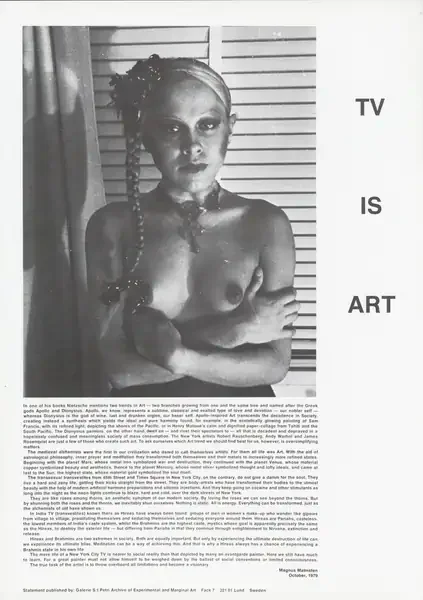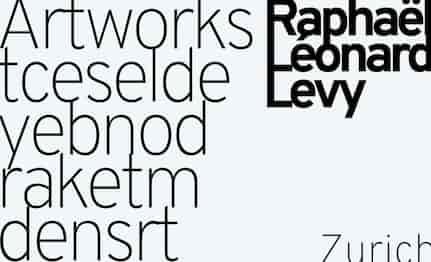CLICK TO VIEW PRESS RELEASE

MAGNUS MALMSTENTV IS ART19.10.1979
TV IS ART
In one of his books Nietzsche mentions two trends in Art — two branches growing from one and the same tree and named after the Greek gods Apollo and Dionysius. Apollo, we know, represents a sublime, classical and exalted type of love and devotion — our nobler self — whereas Dionysius is the god of wine, lust and drunken orgies, our baser self. Apollo-inspired Art transcends the decadence in Society, creating instead a synthesis which yields the ideal and pure harmony found, for example, in the ecstatically glowing painting of Sam Francis, with its refined light, depicting the shores of the Pacific, or in Henry Matisse’s calm and dignified paper-collage from Tahiti and the South Pacific. The Dionysius painters, on the other hand, dwell on — and refer their spectators to — all that is decadent and depraved in a hopelessly confused and meaningless society of mass consumption. The New York artists Robert Rauschenberg, Andy Warhol and James Rosenquist are a few of those who create such art. To ask ourselves which Art trend we should find best for ourselves, however, is oversimplifying matters.
The mythical alchemists were the first in our civilization who dared to call themselves artists. For them all life was Art. With the help of astrology and philosophy they mixed chemical substances and bathed themselves and their metals in increasingly more refined materials. Beginning with the belief that the base metals symbolized our earthly matter, they symbolized them with the planet Venus, whose material charm symbolized beauty and softness, hence to the planet Mercury, whose metal silver symbolized thought and identity, and so, one may say, the philosopher reached that whole state of mind called the soul itself.
In the same way the alchemists’ work finds its modern analogue in New York City. On the contrary, do not glorify the eccentric but let him have and enjoy life instead of kick standing on the street. They are body-artists who have transformed their bodies to the utmost beauty in the true sense, changing their misery into gold and silver, their chaos into joy, despair into devotion, ugliness into form, loosening their hooks from the mad machine of industrialism and collective existence. They are people who can see beauty in suffering. They are like roses and thorns, an aesthetic symbol of our modern society. By loving the roses we can see beyond the thorns. But through the thorns we can show the beauty within ourselves. Nothing is static. All is energy. Everything can be transformed just as the alchemists of old have shown.
In New York today prostitution itself has reached an aesthetic status; music grows within women’s make-up who wander the sidewalks from village to village, prostituting themselves and seducing men and seducting everyone around them. Hiera and Parikas, classic priestesses of Dionysus, had the task of delivering their female bodies as ecstatic mystic whores whose goal is apparently holy. The goddess of love and of beauty manifests her divine truth through the medium of the temple and of the body — and here America experiences its real releases.
Apollos and Brahmins are two extremes in society. Both are equally important. But only by experiencing the ultimate destruction of life can the individual attain bliss. Meditation and self-denial are therefore as important as the physical self-revelation of experiencing Brahmanism or sexual liberation.
The mere life of a New York City TV is nearer to social reality than that made by any avantgarde painter. Here we still have much to learn. For a great painter must not allow himself to be hindered by the ballast of social conventions or limited consciousness.
The true task of the artist is to throw overboard all limitations and become a visionary.
— Magnus Malmsten
October, 1979
Statement published by: Galerie S:t Petri Archive of Experimental and Marginal Art Fack 7 221 01 Lund Sweden


